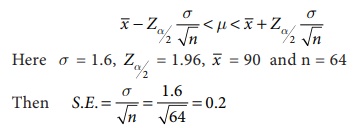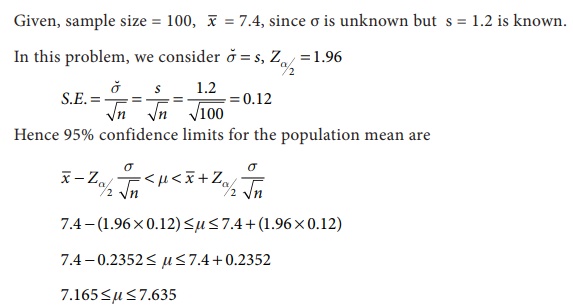with Solved Example Problems | Statistical Inference - Point and Interval Estimation | 12th Business Maths and Statistics : Chapter 8 : Sampling Techniques and Statistical Inference
Chapter: 12th Business Maths and Statistics : Chapter 8 : Sampling Techniques and Statistical Inference
Point and Interval Estimation
Point
and Interval Estimation:
To estimate an unknown
parameter of the population, concept of theory of estimation is used.There are
two types of estimation namely,
1. Point estimation
2. Interval estimation
1. Point Estimation
When a single value is
used as an estimate, the estimate is called a point estimate of the
population parameter. In other words, an estimate of a population parameter
given by a single number is called as point estimation.
For example
(i) 55 is the mean mark
obtained by a sample of 5 students randomly drawn from a class of 100 students
is considered to be the mean marks of the entire class. This single value 55is
a point estimate.
(ii) 50 kg is the
average weight of a sample of 10 students randomly drawn from a class of 100
students is considered to be the average weight of the entire class. This
single value 50 is a point estimate.
Note
The sample mean (![]() )
is the sample statistic used as an estimate of population mean (μ)
)
is the sample statistic used as an estimate of population mean (μ)
Instead of considering,
the estimated value of the population parameter to be a single value, we might
consider an interval for estimating the value of the population parameter. This
concept is known as interval estimation and is explained below.
2. Interval Estimation
Generally, there are
situations where point estimation is not desirable and we are interested in
finding limits within which the parameter would be expected to lie is called an
interval estimation.
For example,
If T is a good estimator
of θ with standard error s then, making use of general property of the standard
deviations, the uncertainty in T, as an estimator of q, can be expressed by
statements like “ We are about 95% certain that the unknown q, will lie somewhere
between T-2s and T+2s”, “we are almost sure that q will in the interval (
T-3s and T+3s)” such intervals are called confidence intervals and is explained
below.
Confidence interval
After obtaining the
value of the statistic ‘t’ (sample) from a given sample, Can we make some reasonable
probability statements about the unknown population parameter ‘ θ’ ?.
This question is very well answered by the technique of Confidence Interval.
Let us choose a small value of a which is known as level
of significance(1% or 5%) and determine two constants say, c1
and c2 such that P (c1 < θ < c 2 |t)
= 1 − α .
The quantities c1
and c2, so determined are known as the Confidence Limits and the
interval [c1,c2] within which the unknown value of the
population parameter is expected to lie is known as Confidence Interval. (1− a) is called as
confidence coefficient.
Confidence Interval for the population mean for Large Samples (when is known)
If we take repeated
independent random samples of size n from a population with an unknown mean but
known standard deviation, then the probability that the true population mean μ will fall in the
following interval is (1−
α) i.e

So, the confidence
interval for population mean (μ),
when standard deviation (σ) is known and is given by

For the computation of
confidence intervals and for testing of significance, the critical values
Za at the different level
of significance is given in the following table:
Normal Probability Table

The calculation of
confidence interval is illustrated below.
Example
8.11
A machine produces a component
of a product with a standard deviation of 1.6 cm in length. A random sample of
64 componentsvwas selected from the output and this sample has a mean length of
90 cm. The customer will reject the part if it is either less than 88 cm or
more than 92 cm. Does the 95% confidence interval for the true mean length of
all the components produced ensure acceptance by the customer?
Solution:
Here μ is the mean
length of the components in the population.
The formula for the
confidence interval is

Therefore, 90 − (1.96 ×
0.2) ≤ μ ≤ 90 + (1.96 × 0.2)
(89.61 ≤ μ ≤ 90.39)
This implies that the probability that the true value of the population mean length of the components will fall in this interval (89.61,90.39) at 95% . Hence we concluded that 95% confidence interval ensures acceptance of the component by the consumer.
Example
8.12
A sample of 100
measurements at breaking strength of cotton thread gave a mean of 7.4 and a
standard deviation of 1.2 gms. Find 95% confidence limits for the mean breaking
strength of cotton thread.
Solution:

This implies that the probability
that the true value of the population mean breaking strength of the cotton
threads will fall in this interval (7.165,7.635) at 95% .
Example
8.13
The mean life time of a
sample of 169 light bulbs manufactured by a company is found to be 1350 hours
with a standard deviation of 100 hours. Establish 90% confidence limits within
which the mean life time of light bulbs is expected to lie.
Solution:
Given: n = 169, ![]() = 1350 hours, s = 100 hours, since the level of significance is (100-90)% =10% thus a is 0.1, hence the significant value at 10% is Za/2 = 1.645
= 1350 hours, s = 100 hours, since the level of significance is (100-90)% =10% thus a is 0.1, hence the significant value at 10% is Za/2 = 1.645

Hence 90% confidence limits for the population mean are

Hence the mean life time of light bulbs is expected to lie between the interval (1337.35, 1362.65)
Related Topics